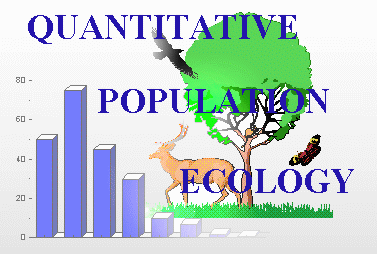 | Population Ecology |
Biology, Entomology, Fisheries and Wildlife Sciences, and Forestry. Major topics are: structure and dynamics of population systems, population demography, sampling, life-tables, temperature-dependent development, predation, competition, dispersal, population stability and pest outbreaks. The course covers contemporary topics in population ecology such as chaos in population dynamics, spatial processes, catastrophe theory, application of geostatistics, etc.Begon M., Mortimer M. 1981. Population ecology: a unified study of animals and plants. Blackwell, Oxford.Population Systems, Analysis of vertebrate populations, Basics of Insect Modelling, An introduction to population ecology, An introduction to systems analysis: with ecological applications, Chaos and insect ecology, Models in ecology, Entomology and pest management, Population and community ecology,Modelling populations in space and time, Analytical population dynamics, Ecological methods with special reference to the study of insect populations, Insect population ecology: an analytical approach |
Quantitative Population Ecology - quantitative population analysis
Major topics are: structure and dynamics of population systems, population demography, sampling, life-tables, temperature-dependent development, predation, competition, dispersal, population stability and pest outbreaks. The course covers contemporary topics in population ecology such as chaos in population dynamics, spatial processes, catastrophe theory, application of geostatistics, etc
the structure and functioning of population systems, to develop simple population models
Prerequisites include statistics (or biometry), and general ecology. The students should be familiar with descriptive statistics, confidence intervals, linear and non-linear regression analysis. From elementary calculus (it is a pre-requisite for statistics) students should know matrix operations and differential equations. From principles of ecology, it is necessary to know the types of interactions between organisms, trophic levels.
Lecture Handouts
Introduction: Population systems and their components.
1.1. What is population ecology?
1.2. Models as analytical tools
1.3. Population system
1.4. Petri nets (optional)
1.5. Questions and Assignments
Estimation of population density and size.
2.1. Censusing a Whole Population
2.2. Simple Random or Systematic Sampling
2.3. How Many Samples?
2.4. Elements of Geostatistics
2.5. Stratified Sampling
2.6. Capture-Recapture and Removal Methods
2.7. Indirect Measures of Population Density
2.8. Questions and Assignments
Spatial distribution of organisms.
3.1. Tree Types of Spatial Distribution
3.2. Random Distribution
3.3. Aggregated Spatial Distribution
3.4. Indexes of Aggregation
3.5. Density-Invariant Indexes of Aggregation
3.6. Geostatistical Analysis of Population Distribution
3.7. Fractal Dimension of Population Distribution
3.8. Questions and Assignments
Statistical analysis of population dynamics.
4.1. Correlation between population density and various factors
4.2. Correlation between factors
4.3. Example: Colored fox in Labrador (1839-1880)
4.4. Autocorrelation of factors and model validation
4.5. Stochastic models based on regression
4.6. Biological interpretation of stochastic models. Response surfaces
Reproducing populations: exponential and logistic growth.
5.1 Exponential model
5.2. Logistic model
5.3. Discrete-time analogs of the exponential and logistic models
5.4. Questions and assignments
Life-tables, k-values.
6.1. Age-dependent life-tables
6.2. Stage-dependent life-tables
6.3. Questions and assignments
Model of Leslie.
7.1. Model structure
7.2. Model behavior
7.3. Intrinsic rate of population increase
7.4. Stable age distribution
7.5. Modifications of the Leslie model
Development of poikilothermous organisms, degree-days.
8.1 Rate of development
8.2 Simple degree-day model
8.3 How to measure temperature?
8.4 Improved degree-day model
8.5 Other non-linear models of development
8.6 Physiological time
8.7 How to combine physiological time with the model of Leslie?
8.8 Questions and Assignments
Stability, oscillations and chaos in population dynamics.
9.1. Introduction
9.2. Attractors and Their Types
9.3. Equilibrium: Stable or Unstable?
9.4. Quantitative Measures of Stability
9.5. Limit Cycles and Chaos
9.6. Questions and Assignments
Predators, Parasites, and Pathogens.
10.1. Introduction
10.2. Lotka-Volterra Model
10.3. Functional and Numerical Response
10.4. Predator-Prey Model with Functional Response
10.5. Host-Parasitoid Models
10.6. Host-Pathogen Model (Anderson & May)
10.7. Questions and Assignments
Competition and Cooperation.
11.1. Intra-specific competition
11.2. Competition between species
11.3. Ecological niche
11.4. Cooperation
Dispersal and spatial dynamics.
12.1. Random Walk
12.2. Diffusion Models
12.3. Stratified Dispersal
12.4. Metapopulation Models
Population outbreaks.
13.1. Ecological mechanisms of outbreaks
13.2. A model of an outbreak
13.3. Catastrophe theory
13.4. Classification of outbreaks
13.5. Synchronization of outbreaks in space
Labs
Orientation in software: Microsoft Excel.
How to write a scientific paper
Population sampling and spatial distribution.
Statistical analysis of population change.
Model of Leslie.
Development of poikilothermous organisms.
Model of Ricker: stability, oscillations, chaos.
Parasitism and biological control
Statistical tables
t-statistics
Chi-square statistics
F-statistics, P=0.05
F-statistics, P=0.01
F-statistics, P=0.001
Population Ecology
What is Population Ecology?
Questions and Assignments
